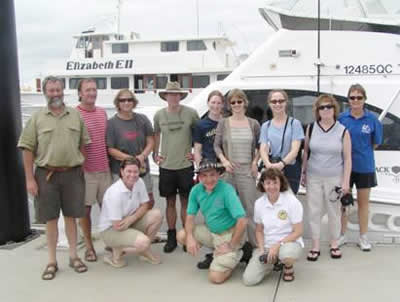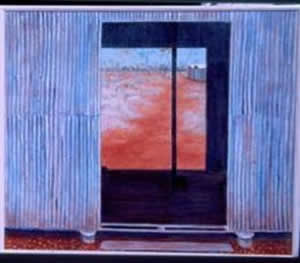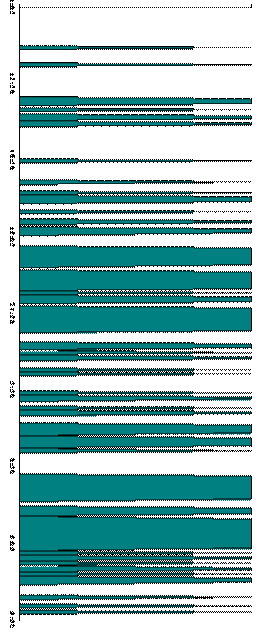
Earthwatch Visit to St Bees
The 15th trip, in four years, to St Bees Island was undertaken between 27th January and 8th February. On the trip we had 9 international volunteers, with 5 from the US, 3 from the UK and 1 from Amsterdam. During the trip we radio tracked our collared koalas, assessed vegetation in a new area of the island and trialled a new radio collar for Delma Clifton's research to accurately describe the microhabitat condition of koalas on St Bees Island and elsewhere in Central Queensland (see report page 5).
The weather was very hot and humid and many of the volunteers coming from the northern hemisphere winter into our hot summer had a hard time dealing with the heat. Alistair, Delma and I also had some trouble coping with the temperatures with no air conditioning to escape to.
We had some sad events during the trip. Two of our long term koalas have died. Those that have been to St Bees may remember koalas, Deirdre and Juliet, both mature females when caught in 2000 and have been tracked ever since. This is good information for the project because we now know that these two were at least 7 years old when they died and we can look into ways of aging other koalas in the population
Report from recent Steering Committee Meetings
25 January, 2005
There are 25 members at present – there is a need to attract younger members – ideas will be gratefully received.
Nick Quigley has finished the web site – this can be accessed by visiting Total4x4 and clicking on the koala icon.
Alistair and Gail to visit St Bees with Delma Clifton and nine volunteers from Earthwatch.
The koala re-introduction project is continuing.
Advertising for the Post Graduate Scholarship will be in February.
Ideas needed for fund raising for this year.
15 February, 2005
Gail was welcomed and gave a report on the recent trip to St Bees. She had photos of all groups from Earthwatch who had visited St Bees over the years.
Gail would like to form a committee to work on the web site with Nick. If interested contact Gail.
More news re new projects in next newsletter.
Many ideas for fund raising were presented. These will be discussed at the next meeting.
Request from Carmen and Dawn – they would like as many small koalas as possible to replenish their 'Orphan Koala' supplies – thanks.
Next meeting 19 April, 2005 at 5.00pm in the Science Meeting Room Greig Turner Building CQU Campus.
Office Bearers
Alistair Melzer, Signatory, Chairperson
Carmen Drake, signatory, CQKV representative on Koala Research Centre Board
Shirley Hopkins, Signatory, Treasurer
Gail Tucker, Minute Secretary
Doreen Lovett, Editor Newsletter, email
Direct correspondence and Central Queensland Koala Volunteers
PO Box 1489
Rockhampton, 4700.
or call Denise on 0749309944 and leave a message.
CQ Koala Volunteers seek the conservation of the koala and other tree living mammals in Central Queensland by
§ Supporting research into koalas, other arboreal mammals and their habitat through (a) providing volunteer support to research projects, and (b) assisting in the raising of funds for research and the volunteer teams
§ Developing public awareness of the needs of koalas, tree living mammals and their habitat requirements generally
§ Fostering community support for koalas and tree living mammals generally
§ Encouraging and assisting with the development of habitat rehabilitation projects where necessary through the region
§ Supporting the rehabilitation and release of sick, injured or displaced koalas and tree living mammals
The Central Queensland Koala Volunteers are not about stopping development. They seek to encourage planned development, which allows for the co-existence of koalas and other tree living mammals with human activity.
Funds are used to buy equipment for the researchers, to fund volunteer field teams and provide limited support for animal carers. Donations may also be made to the Koala Research Centre of Central Queensland and are tax deductible.
Launch of new plan to protect our koalas
On Monday, 31 January, 2005, Premier Peter Beattie and Environment Minister, Desley Boyle released the draft Nature Conservation (Koala) Conservation Plan and Management Program 2005 for community consultation.
The plan is a serious proactive step to halt the decline in Queensland's koala numbers. It includes management strategies and guidelines to address the key threats to koalas including habitat loss, disease, car strikes and domestic dog attacks.
The strategies and guidelines have been tailored to suit various koala populations, with strongest management requirements aimed at south-east Queensland, where the koala is listed as vulnerable and threats are the greatest.
Management strategies outlined in the plan are the result of our Agency's extensive consultation with conservation groups, developers and government agencies.
Minister Boyle also gave effect to a new State Planning Policy (SPP 1/05) that will provide interim protection from inappropriate planning decisions across 9 local government areas in southeast Queensland. This SPP supercedes SPP 1/97 covering the Koala Coast and expands protection to other important koala habitat. EPA staff will immediately be contacting affected councils to provide training on the new SPP requirements.
Queensland is fortunate to have one of the largest natural populations of koalas – however we're at risk of losing the koala to the impacts of urban expansion and habitat clearing.
You are encouraged to have a look at the plan and associated documents, available now on the EPA website.
The community is invited to have their say on the plan until Wednesday, 30 March, 2005. Copies of the draft Koala Conservation Plan are available at Naturally Queensland, 160 Ann Street or online at the EPAs web Site (See note from Gail below)
Submissions can be sent to:
Draft Nature Conservation (Koala) Conservation Plan 2005 Wildlife Management and Education Branch Environmental Protection Agency, P.O. Box 15155 City East, Qld 4002.
Alternatively, submissions can be e-mailed to:
All EPA comments about the plan and its contents will be coordinated through Wildlife Conservation Branch in Brisbane on (07) 3247 5975. Any media enquiries should be directed through central office Marketing and Communications Branch.
Geoff Clare
Executive Director
Conservation Services
Note: Gail has advised members who do not have access to the web that they are welcome to use the volunteers' computer at the University to view the report. Contact Denise on (07) 4930 9944.
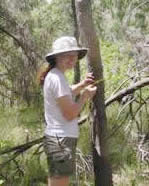 |
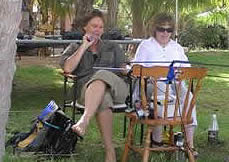 |
| Corinne measuring tree on the Vincent Bay Knoll |
Delma and Kathy collect data while sitting on the beach
– every researcher's dream! |
New technology being developed by PhD student Delma Clifton will remotely monitor the temperature being experienced by koalas and give an indication of their activity by reporting movement. This will enable Delma to accurately describe the microhabitat condition of koalas on St Bees Island and elsewhere in Central Queensland. A trial of the new collar prototype was done on one animal during the last trip to St Bees and produced the following preliminary data of koala movement over a 24 hour period.
| Stationary Moving
|
0900 hours
1200 hours
1500 hours
0000 hours
0300 hours
0600 hours
0900 hours |
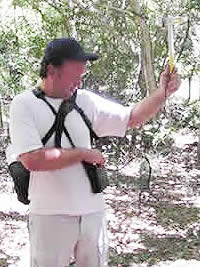 |
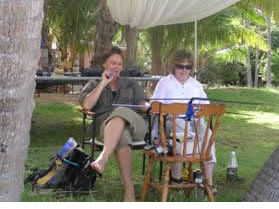 |
Phil
radio tracking |
Kathy Maurits and Janet return from a hard day's work |
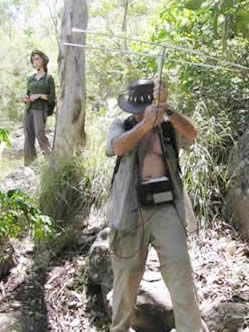 |
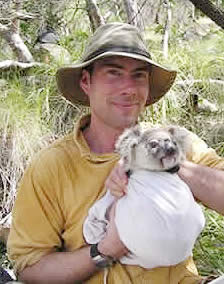 |
Alan
radio tracking |
Maurits
named koala 'Umbrella' meaning little thing in the shade |
